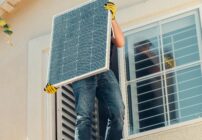If energy efficiency is the name of the game, hardly any home will have a chance at standing on the podium. The more you think about it, our homes have continued to be inefficient for decades. It’s because there are a ton of issues, both from the inside and outside of the home, together with logistics. The inside of the home isn’t properly insulated. There are conflicting techniques and materials. From the outside, the weather is ever-changing, presenting your home with a new task to secure itself every year, throughout all four seasons. Then the logistics of being supplied with efficient and consistent power, that is affordable. Together with this you have the dangers of natural disasters like floods, fires and more. Just how on earth do you win the efficiency game these days?
Going down the sink
Much of our most efficiency goes down the sink, literally. When we use hot water to wash our hands, wash our food or our dishes, this is when the majority of waste occurs. You’ve probably been guilty of this. Do you leave the water running on when you leave the room but plan on quickly coming back? Do you actually have the tap wide open when all you need isa slow steady run? Do you find that you wash one dish at a time and leave the tap running?
All of these issues could be solved if you were to click here and install a water heater for your sinks and faucets. This means that hot water is only produced when you demand it and it doesn’t get stored in a boiler tank. You also don’t need to deal with the boiler which would have to raise the temperature of the water and heat your home all by itself. This could save you hundreds of dollars a year.
Air flow or air conditioning?
You’d be surprised at how much energy the air conditioner actually uses. The thing is, it’s an electric heater essentially, that takes time to warm up and then needs to perpetually use energy to maintain a certain set temperature. So if you want to keep your home cool, then you need to prevent the air in the room from getting warm in the first place.
The trick is to know how airflow works in confined places. The air in your home doesn’t ever stop moving. You can see this by putting your hand close to the bottom of a closed down and feel the breeze coming in or out of the room. You can harness this by placing a fan about 10-feet away from an open window. This is the optimal distance from a window that helps to accelerate air flow around the house. All you need to do is to open one window and the air in your home will be sucked out the home, creating an air flow like a current.
Double to triple
Nowadays, even double glazing is old news. The reason for this is, triple glazing is so much more effective and gives you a lot more savings throughout the entire year. Double glazing works by placing two windows together that have a vacuum in the middle. This prevents heat molecules from escaping as quickly. However, they eventually find their way out from the sides of the window frames. With triple glazing you slow this down further because there are two vacuums instead of one, and a stronger frame.
The thing is though, triple glazing costs a lot more. They can sometimes run double the cost if you get ones that are worth buying. The energy saving is clear to see and this is why the price for installation remains high. Not to mention, your windows might ultimately become thicker and thus more space is needed for the fitting and many homes were not destined for it. Creating a new frame is also part of the trouble. But in the end it’s financially worth it.
Replace the floor
Even if you insist on having a hardwood floor, there are some better woods to choose from. Oak is famous for having a very dense structure, it’s heavy and it can flex as well. This is the type of wood you should get if you want to save on energy bills. It has a complex structure which gives it its strength, but this means that heat is released slowly and hence, it’s been used to build homes since the ancient days of civilization.
You can also choose to have a treatment on the wood that doesn’t prevent heat from being trapped. Resins and varnishes prevent this, but oil finishes do not. So think about having an oil treatment for your hardwood floor.
Efficiency is a like a game of cat and mouse. Just when you think you’ve trapped heat in your home, it finds an escape hatch. Hopefully these tips will now allow your home to win a few battles.
Spraying the loft
These days, insulation is done at a very high tech level. The best companies will use a spray foam which hardens ounces when it’s dry. You can have this kind of insulation in larger areas of the home, but also in between the walls. However, it’s harder to get it into small areas if you want layering. So what is spray foam insulation layering?
Much like a beehive that has several layers to it, spray foaming is about creating a complex system of foam layers that will act as a maze to stop heat escaping the home. Not home can ever truly lock in heat but you can slow it down. The layers will act to push some heat molecules back into the center of the room, and others to travel a long way to finally push outside of the home.
If you have a loft that is always cold and perhaps you don’t have insulation, you should take a look at spray foam services that are near you.
Hope these tips help you make your home more energy-efficient!
Related Posts
- 10 Must-Do Renovations that add Value to your Home
If you’re currently considering selling your home, the best thing that you can do is…
- 4 Easy Tips for Maintaining Your Home
It is undeniable that 2020 has been an incredibly challenging year for everybody, but it…
- How to be more efficient when you Work from Home
If you want to make sure that you are making the most out of your…


















